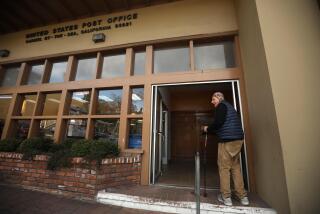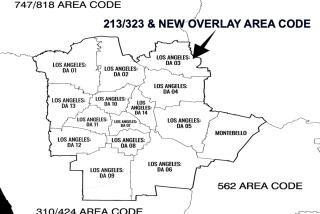The Cutting Edge: COMPUTING / TECHNOLOGY / INNOVATION : Numbers Crunch : Whether ‘Overlays’ or New Areas, You Can Count on Dialing Changes
- Share via
WASHINGTON — A record 14 telephone area codes are scheduled to change this year in North America as the communications industry struggles to cope with a phone number shortage spawned by an explosion of fax machines, cellular phones and other communications devices.
Callers from Southern California to Bermuda will face a confusing array of non-traditional three-digit area codes. Some will not have the usual 0 or 1 as the middle number, and a few--such as the proposed 562 area code in the 310 dialing area covering western Los Angeles County--will “overlay” existing area codes and thus will not have distinct geographic identities.
The changeovers will require tens of millions more Americans to dial 11 digits for many of their local calls. And the controversial overlay area codes eventually could saddle residents with different area codes for telephones at the same location--say, a fax machine and a voice line. The California Public Utilities Commission will begin administrative hearings on the hotly contested 562 overlay next Monday.
For many businesses, some of the area code changes could be wrenching. Because some old phone equipment was designed to recognize only area codes that have 0 or 1 as the middle digit, businesses with aging private branch exchanges, or PBXs, may be unable to reach the new area codes unless they make costly modifications to their equipment.
“This is massive change that will create confusion . . . not only among consumers, but businesses” that don’t update their phone gear, warns Richard Nespola, head of the Leawood, Kan., telephone consulting firm Management Network Group Inc.
The latest numbering upheaval, which began in January when western Washington state supplemented its 206 area code with a new 360 code, is the result of massive telephone number depletion. Each three-digit area code can support about 7.8 million seven-digit phone numbers. But popular communications services such as cellular phones, pagers and mobile radio phones are gobbling up more than 8,000 new telephone numbers a day.
Rapid growth in home offices and personal computers--with their attendant fax machines and communications modems--is also fueling demand for phone lines. Some 14% of Pacific Bell’s residential customers now have two phone lines--the percentage has risen sharply in the past five years.
Though the potential addition of 640 area codes using middle digits other than 0 or 1 will give the industry some breathing room, demand for new numbers will eventually force it to rethink the nearly century-old dialing distinction between a local and a long distance call.
Experts say callers everywhere may soon be required to dial at least 11 digits to reach anyone--whether long distance or local--or the industry may have to introduce so-called “portable” exchanges. These would be assigned to an individual much the way a social security number is, and remain with the person no matter where he or she is.
The numbering turmoil has intensified the already bitter feud between the regional Bell phone companies and upstart communications service companies over phone number allocation.
New telephone access providers such as New York-based Teleport Communications Group and cable TV operators--which are seeking to provide phone service through cable TV wires--say there is an inherent conflict of interest in letting the regional Bells allocate numbers.
The practice, said Robert Atkinson, director of federal regulatory affairs at Teleport, “confines competitors and their customers to second-class citizenship. . . . You get this strange, unknown area code; no one knows where it is or what it is. It’s a huge inconvenience.”
In California, Pacific Bell--which upset many subscribers when it carved the 310 area code out of the 213 area in 1991--is now under fire for its overlay proposal. The 562 numbers would be given to new phone providers--such as cellular carriers and cable TV firms just entering the phone business--a year before new Pac Bell customers would get them.
In a petition submitted to the Federal Communications Commission last month, the California Cable Television Assn. complained that the plan “creates a dialing disparity between the customers of Pacific, the vast majority of whom are located with in the 310 area code, and the customers of new market entrants and other carriers, most of whose customers will be relegated to the new area codes.”
The association noted that “the customers of new market entrants will be required to dial 11 digits to reach the vast majority of numbers within the overlay area, whereas Pacific’s existing customers will generally be able to dial only seven digits.”
“The Pacific Bell proposal is anti-consumer and anti-competitive,” fumed Richard Severy, MCI Communications Corp. director of regulatory and government affairs in the western region. “They are mismanaging the numbering resources in California. They’ve made assumptions about future telephone use that don’t make sense. Are we really in as serious a situation as Pac Bell claims we are” just four years “after they introduced the 310 area code in 1991?”
Paula Olivares, area code relief coordinator for Pacific Bell, said the number crunch is real. But she said she doesn’t believe the new overlay area code will be confusing or discriminatory.
“Because we have so many area codes in Southern California, people are used to dialing 11 digits,” Olivares said. She added that “although we are going to allocate numbers beginning in September, 1995, to just pagers and cellular companies,” eventually the new 562 area code will apply to anyone seeking to add a phone, so there will be no discriminatory effect.
The alternative, Pac Bell says, would be yet another inconvenient area code split. An overlay area code, 907, was recently introduced in New York with little fanfare--and little opposition.
Indeed, despite the grumbling of Pac Bell’s competitors, a few businesses are embracing the more complex area codes--convinced that their distinctiveness offers a big marketing opportunity.
Because the 562 area code in Los Angeles will be allocated to wireless phone services many months before wired phones start to make the transition, Marc O’Krent, president of the Telephone Connection of Los Angeles, sees 562 as a great marketing opportunity.
“In the beginning I wasn’t that excited about the new area code,” O’Krent said. “But we think people will look at it as an 800 number for wireless carriers.”
In the Chicago area, however, wireless service providers were a lot less enthusiastic about getting a special area code. They forced the regional Bell company Ameritech to rescind a plan that would have assigned a new 360 area code only to wireless providers in the Chicago area.
But experts say there’s no escaping the coming area code confusion.
“We’re living in a 10-digit world,” O’Krent said. “I think people will come to the realization that there’s just no other choice in this country. Too many people want phones. It’s become a (central) part of our lives.”
(BEGIN TEXT OF INFOBOX / INFOGRAPHIC)
Time is Ringing Out
Almost 50 years after the debut of the area code, the American telephone system is approaching its carrying capacity. With fax machines, pagers and cellular phones gobbling up 8,000 new numbers a day, the industry is rethinking its dialing system. For Los Angeles, local phone companies have proposed the creation of a 562 “overlay” area code, an alternative to splitting the soon-to-be-filled 310.
* Telephone patent: Alexander Graham Bell was awarded patent number 174,465 in 1876 in response to his application for an “improvement in telegraphy.” Bell communicated the first words on the telephone to his assistant after he accidentally spilled a jar of acid: “Mr. Watson, come here, I want you!”
* Pay phone invented: The coin-operated telephone was invented by William Gray in 1889. The first pay phone was installed in the Hartford Bank.
* Numbers were numerals: Americans were first able to dial directly without the help of a switchboard operator in 1924. An operator still connected the call, however, after a caller dialed the first two letters of an office name--FA in the case of the Faber office--and then the numerals. The letters connected the caller to the office, and the operator used the numerals to complete the connection.
* Origin of the seven-digit phone number: In 1946 executives at the American Telephone & Telegraph company realized they were running out of numeral prefixes and switched to numbers. Area codes were used to direct the caller to different parts of the country. Each phone number contained seven numbers after tests showed people could best remember a number with seven or fewer digits. California didn’t convert to all numeral calling until 1962.
* Area code attachment: Since the proliferation of new area codes countrywide, telephone companies have noticed that residents’ phone numbers become part of their identity. In fact, Fred Sands, a well-known real estate executive, said that he had heard people from Beverly Hills put down San Fernando Valley residents as “real 818s.”
* West Hollywood split: In 1992 Pacific Bell decided to shift 2.4 million customers in the western sections of Los Angeles County from the 213 area code to the 310 prefix--splitting the five-square-mile city of West Hollywood practically in half.
* Shorter chats: A surprising and unintended consequence of pagers, electronic mail and voice mail has been shorter telephone calls. Today about 52% of Americans’ residential phone conversations last one minute or less, compared with 22% in 1982.
Sources: Bell Laboratories, Famous First Facts, Times wire services. Researched by JENNIFER OLDHAM / Los Angeles Times
More to Read
Sign up for Essential California
The most important California stories and recommendations in your inbox every morning.
You may occasionally receive promotional content from the Los Angeles Times.












